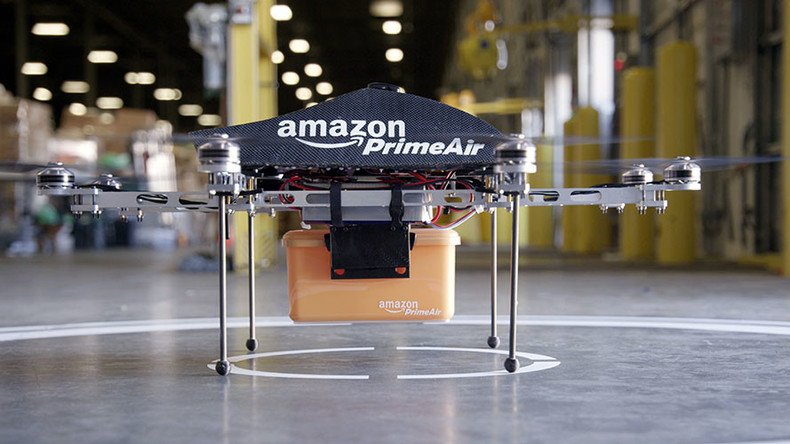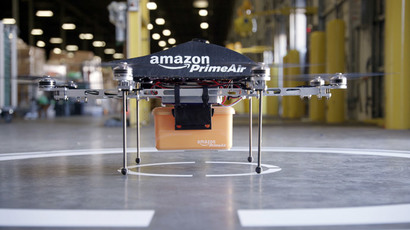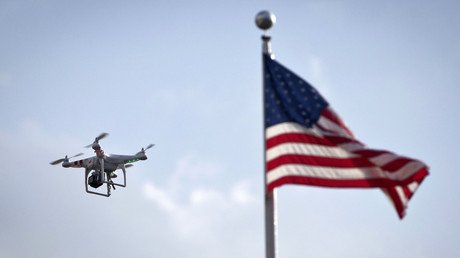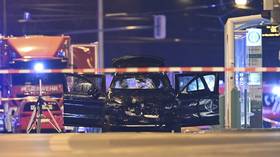Horse-like drones: Amazon shares plans to deal with flight obstacles, haters with shotguns

Amazon’s plans to create a fleet of automated drones to deliver packages straight to customers’ doorsteps are widely known. But now the company is addressing concerns about noise pollution, collisions and even people who might try and shoot drones down.
In an interview with Yahoo News, Amazon Vice President of Global Affairs Paul Misener explained that the company is trying to implement a high-tech delivery system to get small packages to customers in 30 minutes or less – a far shorter period than a driver navigating a system of roads would require.
“It’s really to fulfill a need that we believe our customers have. Usually they need that delivery in a few days, and that’s sufficient,” Misener told Yahoo News. “But what if one of your grandchildren is already visiting you, and she’s playing with an electric truck on the floor, and the battery wears out? On one hand, you could get her all bundled up, put her in the car, and drive to the store to get the battery replacement, and drive all the way back. Wouldn’t it be so much better if you could just go online from Amazon and order it, have it delivered in 30 minutes?”
While it isn’t clear whether it will cost more or less than traditional delivery, a drone can literally move as the crow flies to transports customers’ packages which weigh five pounds or less. The “vast majority” of items sold at Amazon fall within this restriction.
While the convenience of having packages flown straight to homes by unmanned aerial vehicles is undeniable, many have questioned the safety of such a system. Of all the possible issues, Misener is not concerned about the problem that shotgun-wielding, anti-drone vigilantes might pose. "I suppose they could shoot at trucks, too," he said. "We want to make the deliveries. And we believe that these Prime Air drones will be as normal as seeing a delivery truck driving down the street someday. So the novelty will wear off."
READ MORE: Net-shooting 'drone catcher' billed as solution to 'rogue' UAVs
Another, perhaps more down-to-earth consideration is the devices safely delivering a large variety of different environments where customers leave, from dense cities to rural areas.
“Obviously, our customers live in a wide variety of buildings. Some live in rural farmhouses, some live in high-rise city skyscrapers, and then everything in between, in suburban and exurban environments. We want to be able to serve all of those customers.
"And it may take a different kind of a drone to best work in each one,” Misener said, adding that Amazon is working on the issue of delivering to people without yards that provide a landing space for the drones. Landing on apartment building roofs and courtyards is a solution that has been considered.
Navigating such diverse obstacles requires sophisticated technology that is much different from consumer drones that can be bought off the shelves. They are equipped with “sense-and-avoid” technology that prevents them from running into obstacles, giving them the awareness of an animal.
“These drones are more like horses than cars – and let me explain why,” Misener said. “If you have a small tree in your front yard, and you want to bang your car into it for some reason, you can do that. Your spouse might not be happy with you, but you can do it. But try riding a horse into the tree. It won’t do it. The horse will see the tree and go around it.
"Same way our drones will not run into trees, because they will know not to run into it.”
As difficult and futuristic as the engineering hurdles might seem, the “automation technologies already exist,” Misener assured. The real issue, he said, is getting governments and regulatory authorities to play ball.
“The regulatory issues to which you refer are difficult. And once we demonstrate the safety of the system, we believe that the regulations will quickly follow,” he said.
One of the biggest obstacles to actually implementing such a system is the fear that the devices will interfere with planes. To alleviate these concerns, Amazon has proposed to the FAA and regulators around the world a separate airspace that is lower to the ground.
This would eliminate the competition of airspace zone, with “manned aircraft above 500 feet. Between 400 and 500 feet there’d be a no-fly zone – a safety buffer. Between 200 and 400 feet would be a transit zone, where drones could fly fairly quickly, horizontally,” Misener said.
Going hand-in-hand with demonstrating the safety of the devices to the governments is demonstrating an acceptably low level of obnoxiousness to the public. Amazon delivers millions of packages a week, and one of the fears is that so many drones moving through the sky would create noisy buzzing. Misener assured, however, that it’s not going to be a “science fiction, Hitchcock scenario.”
“But if we design these correctly, they won’t be loud and obnoxious and noisy,” he added. “It’s a really cool engineering challenge, it turns out. I mean, there are a bunch of challenges. But dampening the noise is one of them.”
While the whole project seems so far out there that it seems like a marketing ploy, Misener assures that Amazon is very serious about the project.
“I can tell you, it is very real. We’ve beefed up a team at Amazon Prime Air that includes aeronautical engineers, roboticists, a former NASA astronaut. These folks are completely focused on making this a reality – and demonstrating that it is safe before we begin operations.”














